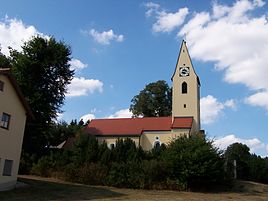Grießenbach (Postau)
|
Grießenbach
municipality Postau
Coordinates: 48 ° 38 ′ 27 ″ N , 12 ° 17 ′ 51 ″ E
|
||
|---|---|---|
| Incorporation : | April 1, 1971 | |
|
Location of Grießenbach in Bavaria |
||
|
The branch church of St. Stephanus
|
||
Grießenbach is a district of the municipality of Postau in the Lower Bavarian district of Landshut . Until 1971 it formed an independent municipality.
location
Grießenbach is about two kilometers southwest of Postau on the edge of the Isar valley .
history
The large burial mounds from Täuberlberg in the direction of Einaich probably date from the Hallstatt period around 600 BC. The Burgstall west of Hahnreut refers to a former, smaller castle, about whose demise nothing can be proven. Around the beginning of the 6th century AD, the Bavarians settled in the area.
In 1124 the Grießenbeck family came here, originally from the Obergriesbach and Griesbeckerzell settlements . The Grießenbeckers built a castle and one dedicated to St. Chapel dedicated to Stephan. It was from them that the place got its name. Grizpah or Grizpach , as it is called in older documents, comes from the old German groiz, later gries, grit gravel and means "gravelly brook".
From 1280 to 1721 the upper ownership of Grießenbach was transferred to the Seligenthal monastery . During the Thirty Years War , the Swedes set fire to the estate twice in 1634 and 1648. On October 14, 1721, Felix Anton Ritter von Grießenbeck was able to repurchase the castle and its accessories from Seligenthal Abbey. From 1732 to 1842 Grießenbach Hofmark was in the Landshut Rent Office and the Rottenburg judicial district . The Patrimonial Court II. Class Grießenbach under the jurisdiction of Barons Anton and Siegmund von Grießenbeck with court seat Oberköllnbach was confirmed on March 22, 1828. Around 1848 the land was transferred to the farming farmers.
Grießenbach belonged to the justice office (district court) and district office created in 1862, and since 1939 district office in Landshut. Important events were the opening of the Landshut – Plattling railway with the Wörth station in 1865 and, from 1931, the Fuchs bus from Mengkofen via Grießenbach to Landshut. The municipality of Grießenbach was merged with the municipality of Postau on April 1, 1971 as part of the regional reform in Bavaria .
The drainage of the Isar moss began in 1907 and was completed in 1924. A remaining remnant forms, among other things, the only breeding area of the Redshank in Lower Bavaria was therefore designated as a bird sanctuary meadow breeding areas in the lower Isar valley - sub-area Mettenbacher and Grießenbacher Moos .
Attractions
- Filial church St. Stephan. The church, probably built around the middle of the 14th century, received its tower with a steep gable roof and the sacristy a little later. The interior with the three altars is baroque. The three church bells were donated by Georg Grießenbeck and cast by the bell caster Dandl in 1583 "in honor of Mary and in memory of Abbess Apollonia from the Seligenthal monastery in Landshut".
- Old castle. The castle of the Lords of Grießenbeck, built around 1124, is shown in an engraving by Michael Wening in 1710 and is only partially preserved today.
- New lock. It was rebuilt in the 20th century.
societies
- Volunteer fire brigade Grießenbach
- King Ludwig Association Grießenbach
literature
- Hans-Dieter Becher: Landshut. The city of Landshut and the district court of Rottenburg . I / XLIII in the Historical Atlas of Bavaria , Munich 1978, ISBN 3-7696-9906-8

